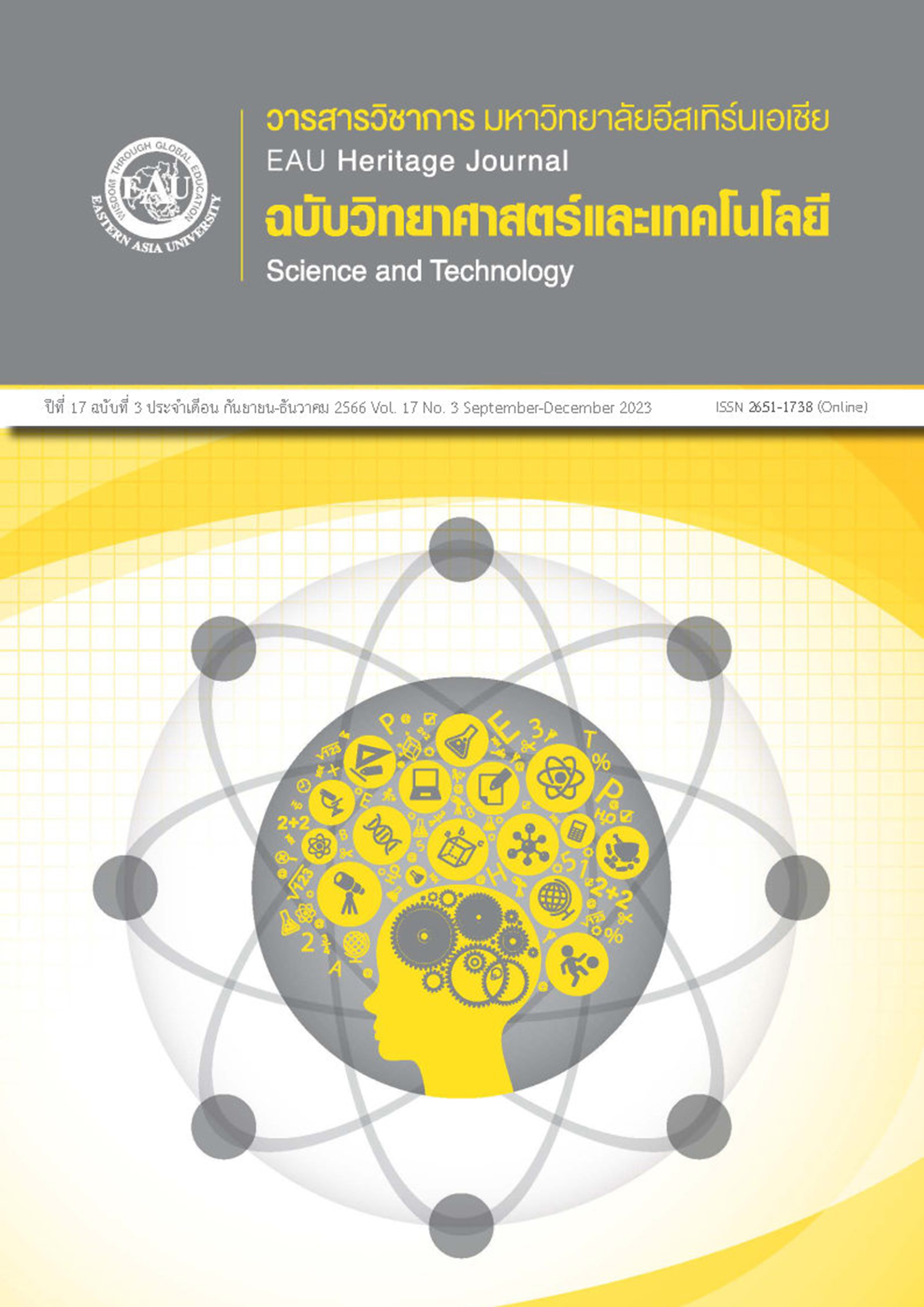การศึกษาประสิทธิภาพ การออกแบบ การทำงานของเซนเซอร์วัดฝุ่นละออง
คำสำคัญ:
เซนเซอร์วัดปริมาณฝุ่นละออง, ฝุ่นละอองบทคัดย่อ
ฝุ่นละอองขนาดเล็กมี 3 ขนาดที่ใช้เรียก ได้แก่ PM10 PM2.5 และ PM0.1 ซึ่งเป็นฝุ่นละอองที่สามารถลอยในอากาศได้ในระยะเวลานาน เนื่องจากมีอนุภาคเล็กจึงมีโอกาสในการเข้าสู่ปอดได้มากส่งผลต่อระบบทางเดินหายใจในระยะยาว ในปัจจุบันเมื่อเทคโนโลยีแอพพลิเคชันและสมาร์ทโฟนได้รับความนิยมมากขึ้น นักพัฒนาระบบพยายามนำเครื่องมือที่เรียกว่า IoT ช่วยอำนวยความสะดวกให้กับมนุษย์ โดยการตรวจวัดปริมาณฝุ่นละอองแบบอัตโนมัติ เพื่อให้เลี่ยงพื้นที่อันตรายและเสี่ยงต่อการสูดดม ซึ่งอุปกรณ์ที่ช่วยในการทำงานที่สำคัญ คือ เซนต์เซอร์ ที่ทำหน้าที่หลัก ดังนั้นบทความนี้มีวัตถุประสงค์ในการเปรียบเทียบเซนต์เซอร์สำหรับวัดปริมาณฝุ่นละออง PM10 และ PM2.5 โดยเป็นการเปรียบเทียบการทำงานของเซนต์เซอร์ จำนวน 4 รุ่นประกอบด้วย PM3003 PM5003 PM7003 และ GP2Y1010AU0F สำหรับการใช้งานในพื้นที่ การออกแบบ เทคนิคที่ใช้ และประเมินผลที่ได้
เอกสารอ้างอิง
Champa, L. (2022). Development of PM2.5 dust meter using dust sensor and notifying via application. Journal of Science and Technology, Ubon Ratchathani University, 24(1), 48-55. (in Thai)
Charoenchansa, A. (2022). Pollution Control Department Ministry of Natural Resources and Environment Raising the level of PM2.5 standards, the royal gazette has announced enforcement. Retrieved from https://www.pcd.go.th/pcd_news/26385. (in Thai)
Chuasuwan, P., & Tongthong, T. (2021). Dust monitoring system in building construction projects by unmanned aerial vehicles. The 26th National Convention on Civil Engineering (pp. 1-8). Bangkok: King Mongkut’s Institute of Technology Ladkrabang. (in Thai)
Daily News Online, (2023, February 3). School closed! Many schools in Bangkok have gradually ordered the suspension of classes to avoid PM2.5 dust. Daily News Online. Retrieved from https://www.dailynews.co.th/news/1956817 (in Thai)
Dechapong, T. (2023). Thailand’s air quality is ranked 4th in the world, behind only Mumbai, Wuhan and Chengdu. So which countries have good weather?. Retrieved from https://www.brandthink.me/content/thailand-no-4-polluted-cities
Deecharoenchitpong, J., & Tortrakul, P. (2019). The development of dust detection and warning system prototypes by Internet of Things. Journal of Science and Technology Thonburi University, 3(1), 34-43. (in Thai)
Electronic Components Datasheet Search. (2023). Alldatasheet.com. Retrieved from https://www.alldatasheet.com/view.jsp?Searchword=PM7003 (in Thai)
Kongtip, T., Kaweekitprasert, A., Jitkamnungsuk, S., & Phakakoew, T. (2021). Web application development for air purifier control with internet of things. The 13th National Conference Phuket Rajabhat University: Multidisciplinary Integration for Local Development (pp. ST07-1). Phuket: Rajabhat University (in Thai)
Martmonthana, M., & Kemapatapan, C. (2021). Delelopmet of equipment to measure temperature, humidity, dust in the air and dust notification inquiry system via LINE chatbot (Master’s thesis). Dhurakij Pundit University. Thailand. (in Thai)
Ministry of Public Health. (2020). Medical and public health operations manual in case of dust particles no larger than 2.5 microns (PM2.5). Retrieved from http://envocc.ddc.moph.go.th/uploads/downloads/do_manual_PM2.5.pdf.
Mungsujaritkarn, S., Nusan, P., Nusan, S., & Kawmorajalearn, M. (2021). Factors affecting particulate matter smaller than 2.5 microns from residential building. The 26th National Convention on Civil Engineering (pp. 1-9). Bangkok: King Mongkut’s Institute of Technology Ladkrabang. (in Thai)
Phamorn, S. (2021). PM10 and PM2.5 characterization on the relationship of diseases related to air pollution in the area of the 4th health zone. An exploratory study (Master’s thesis). Bangkok: National Institute of Development Administration (in Thai)
Phirunkham, T., Meepoo, P., Polamat, S., & Suwannaraj, K. (2022). Mobile PM2.5 dust measure. The 13th Hatyai National and International Conference (pp. 530-541). Songkla: Hatyai University. (in Thai)
Phonrit, O., Arnansanti, N., Laotrakulngam, N., & Wattana, N. (2020). Measuring dust system in the air on smartphone devices. Journal of Information Science and Technology, 10(1), 1-9. (in Thai)
Pollution Control Department. (2023). Air Quality Index: AQI. Retrieved from http://air4thai.pcd.go.th/webV2/aqi_info.php. (in Thai)
Prapankun, A., & Jotisankasa, A. (2020). Application of measurement system for dust control in construction site using IoT (Internet of Things) Technology. The 58th Kasetsart University Annual Conference (pp. 352-361). Bangkok: Kasetsart University. (in Thai)
Rattananimit, W. (2020). Development PM2.5 dust monitoring system on cloud with PMS7003. The 12th National Conference Nakorn Pathom Rajabhat University (pp. 435-442). Nakorn Pathom: Nakorn Pathom Rajabhat University. (in Thai)
Yartit, A., Wannachai, S., Vimonthanasit, P., Thinnakorn, J., & Sampattakun, S. (2019). Development of PM monitor by light scattering principle and comparison with standard device. The 42nd Electrical Engineering Conference (pp. 481-484). Bangkok: Mahidol University. (in Thai)
Yong, Z. (2016). PMS5003 series data manua. Retrieved from http://www.ett.co.th/productSensor/PMS5003_PM_SENSOR/plantower-pms5003-manual_v2-3.pdf







